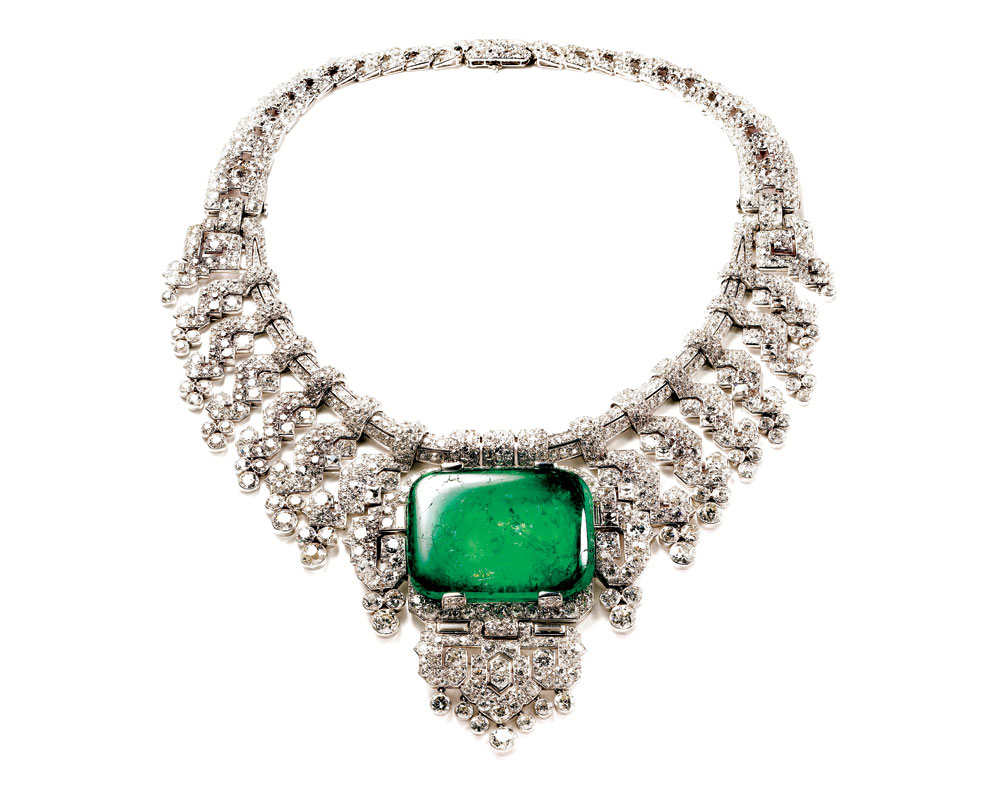
Necklace worn by Countess of Granard, Cartier, London. 1932. Platinum, diamonds, emerald.
Photos courtesy of DAM.
Bling. To say The Denver Art Museum’s (DAM) latest exhibit, “Brilliant: Cartier in the 20th Century,” is just about some fancy jewelry is a major understatement. Yes, there are jewels galore and sparkling gems at every turn. But the new exhibit, which runs through March 15, 2015, is also about craftsmanship, history, social mores and status, with elements for men, women and children.
“Jewelry is as old as humankind,” says Christoph Heinrich, Frederick and Jan Mayer Director of the Denver Art Museum. “It’s ingrained in our DNA to want to elevate ourselves and our status with jewelry.”

The Cartier Collection includes more than 1,500 pieces. Influenced by the Belle Epoque at the turn of the 20th century, the Cartier name established fame with dazzling creations, which were the most sought-after jewels of the European aristocracy and American bourgeoisie. Customers traveled to buy jewels, watches and precious objects. Above: Crocodile necklace made commissioned by Maria Felix, Cartier; Bracelet (coral), Cartier, Paris 1922.
The idea for the exhibit started with Margaret Young-Sanchez, the Frederick and Jan Mayer Curator of Pre-Columbian Art at the Denver Art Museum, more than four years ago during a staff meeting to discuss ideas for upcoming exhibits. In addition to being able to work with a different time frame than she usually does, Young-Sanchez simply loves jewelry and has always been interested in its history. “The opportunity to work with the greatest jewelry house is a dream come true,” she says. Young-Sanchez chose to narrow down the collection to items created by Cartier between 1900 and 1975 because it was a time of so much change in the world.
“Brilliant” takes more than 200 hand-selected items covering the period of 1900-1975 from the more than 1,500 pieces comprising The Cartier Collection to create a one-of-a-kind exhibit that will only be shown at the DAM. Many of the items have never been seen before. Visitors travel along the glamorous Cartier journey from the time of the last czars in Russia, to the Roaring 20s, through the dawn of European royalty willingly mingling with American aristocrats (think Downton Abbey).
The exhibit is divided into themed rooms that combine the jewelry with explanations of how world events were being reflected in Cartier designs. Images, music, wallpaper and mirrors all add to the exhibit experience, giving a sense of glamour and revealing something new around each corner.
To broaden audience appeal, there are men’s jewelry and accessory items such as watches and commemorative pieces. There is also a section devoted to smoking including cigarette cases and lighters and an Egyptian line featuring ancient scarabs, of huge interest due to the discovery of King Tutankhamun’s tomb. Both demonstrate how Cartier turned social trends into fashion.
A room devoted to icons of style is especially impressive with floor-to-ceiling images of Elizabeth Taylor, Grace Kelly and others with some of their most famous pieces of jewelry and memorabilia. A large screen in the corner plays classic film clips that featured beautiful jewelry and the iconic women who wore it.
Part of the exhibit is devoted to the Cartier workshop. Tools and even the messy workspace of a jeweler are featured to impress upon visitors the intense level of expertise and precision required to work at Cartier.
An audio tour is included in the ticket price for adults and children. The kids’ tour is led by fictional Master Jeweler Henri Lapine, who encourages kids to think like an apprentice, noticing tiny details, imaging how items were made and surmising what some unusual items were used for. Henri instructs kids to utter the secret words when turning in their audio devices at the end to receive his business card, a (fake) jewel and instructions for downloading jewelry templates to start their own jewelry-making career.

Laurel leaf tiara worn by Marie Bonaparte, Cartier, Paris. 1907.
A variety of programs have been created to go along with the exhibit including tours, winter break activities, theatrical performances and the Jewelry Studio on the first floor. There, visitors can explore their creativity designing and making jewelry they can take home while also seeing demonstrations by professional jewelers. Visit www.denverartmuseum.org for a full listing of activities and member and nonmember ticket pricing. “Brilliant” is a timed-entry exhibition. Tickets include an audio tour available in adult and family-friendly versions in English and Spanish. General museum admission is included.



0 Comments